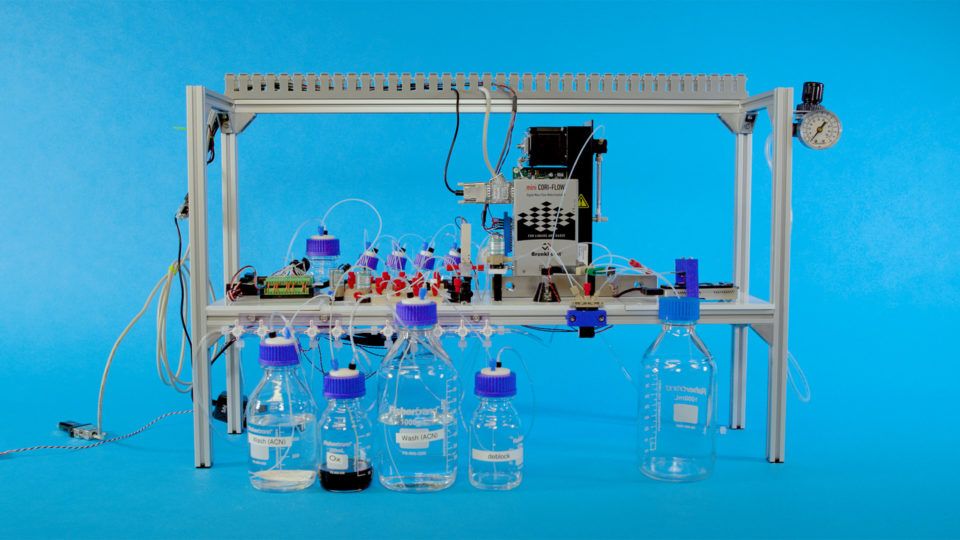Robot hands, microscopic swarms and a backflipping quadruped.




The findings, published on February 18, 2019 in the journal Nature Medicine, highlight a novel CRISPR/Cas9 genome-editing therapy that can suppress the accelerated aging observed in mice with Hutchinson-Gilford progeria syndrome, a rare genetic disorder that also afflicts humans. This treatment provides important insight into the molecular pathways involved in accelerated aging, as well as how to reduce toxic proteins via gene therapy.
“Aging is a complex process in which cells start to lose their functionality, so it is critical for us to find effective ways to study the molecular drivers of aging,” says Juan Carlos Izpisua Belmonte, a professor in Salk’s Gene Expression Laboratory and senior author of the paper. “Progeria is an ideal aging model because it allows us to devise an intervention, refine it and test it again quickly.”
With an early onset and fast progression, progeria is one of the most severe forms of a group of degenerative disorders caused by a mutation in the LMNA gene. Both mice and humans with progeria show many signs of aging, including DNA damage, cardiac dysfunction and dramatically shortened life span. The LMNA gene normally produces two similar proteins inside a cell: lamin A and lamin C. Progeria shifts the production of lamin A to progerin. Progerin is a shortened, toxic form of lamin A that accumulates with age and is exacerbated in those with progeria.

SETI for Bracewell probes? Yes please. Years ago Jill Tarter commented that looking for such probes would be worthwhile. These days we hear about Starshot, sending a fleet of lightweight probes to the nearest star within decades which brings into mind the obvious idea that maybe someone else did so long ago.
One objection to SETI is that it is not falsifiable — there is no point at which a lack of signals can prove that extraterrestrial civilizations do not exist. But there are some aspects of SETI that can be falsifiable. Consider a class of objects near enough for us to investigate not only with listening efforts but with probes, one small enough to be thoroughly covered, and one most people know almost nothing about. Could these offer a listening post for ‘Bracewell probes,’ a way of watching the development of our culture and reporting home to ETI? And if so, could we combine SETI with METI to advance both disciplines without compromising our own security?

If the idea of nearby probes seems far-fetched today, it was even more so when Ronald Bracewell advanced his ‘sentinel hypothesis.’ Bracewell took the question of SETI and stood it on its ear. That was no mean feat in 1960, for SETI was just being born in that year through the efforts of Frank Drake at the Green Bank instrument in West Virginia. While Drake was, reasonably enough, asking whether we might pick up signs of an extraterrestrial civilization around another star, Bracewell had begun to wonder whether there might be a different way to study an alien culture. A long-lived probe could be planted in any system under investigation.

On July 11-12th, we return to the Cooper Union in New York City for our second annual Ending Age-Related Diseases conference, which focuses on the progress in aging research as well as the business side of biotech.
We will be bringing you the latest aging research, investment, and business knowledge from some of the top experts in the industry. We will be packing two days full of talks and discussion panels featuring the people who are developing the technologies that could change the way we regard and treat aging forever.
We are currently offering reduced ticket prices until March 31st, after which the price increases to the regular $400 cost. If you would like to take advantage of this special offer, head on over to our event ticket page to secure your place now.


Like its predecessor, Horizon 2020, the new programme will fund collaborations between academia and industry, and prestigious discovery science. But the agreement also includes some fresh ideas, including a greater focus on innovation and initiatives to help poorer nations compete for funds.
Horizon Europe will fund a mix of academia–industry collaborations and discovery science — but its proposed budget of €100 billion has yet to be agreed. European Union officials have struck an agreement on the basic structure of the bloc’s next major science-funding scheme, Horizon Europe.

When Genevieve posted about optical tweezers, I noticed the similarity with acoustic tweezers, so I needed to post this article as well, so as to add to hers.
A new algorithm recently helped scientists levitate multiple objects using sound waves in very strategic positions. It marked the first time that sound helped capture numerous objects in various positions. The findings were recently published in the journal Proceedings of the National Academy of Science. It was funded by the Engineering and Physical Sciences Research Council (EPSRC) in the United Kingdom.
For the first time ever, an international team of researchers successfully used sound waves to make a series of objects float in strategic locations.

Microsoft has helped build the first device that automatically encodes digital information into DNA and back to bits again.
DNA storage: Microsoft has been working toward a photocopier-size device that would replace data centers by storing files, movies, and documents in DNA strands, which can pack in information at mind-boggling density.
According to Microsoft, all the information stored in a warehouse-size data center would fit into a set of Yahztee dice, were it written in DNA.